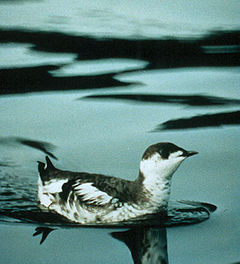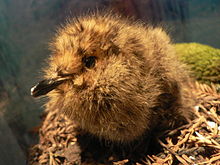Marbled murrelet
| Marbled Murrelet | |
|---|---|

| |
| B. marmoratus | |
| Scientific classification | |
| Kingdom: | |
| Phylum: | |
| Class: | |
| Order: | |
| Family: | |
| Genus: | |
| Species: | B. marmoratus
|
| Binomial name | |
| Brachyramphus marmoratus | |
The Marbled Murrelet (Brachyramphus marmoratus) is a small seabird from the North Pacific. It is an unusual member of the auk family, nesting far inland in old-growth and mature forests. Its habit of nesting in trees was not known until a tree-climber found a chick in 1974. The Marbled Murrelet, together with the closely related Long-billed Murrelet and Kittlitz's Murrelet are thought to have experienced declines in numbers recently. Their decline and association with forests have made them a flagship species in the forest preservation movement.
Description
The Marbled Murrelet is a small (25 cm), chunky auk with a slender black bill. It has pointed wings and plumage that varies by season. The non-breeding plumage is typically white underneath with a black crown, nape, wings and back. The bird closely resembles its closest relative, the Long-billed Murrelet. In fact, these species were considered conspecific up until 1998. They are virtually identical. In breeding plumage, both have a brown mottled body and face. The Long-billed has a pale white throat, lacking in the Marbled. In winter plumage, the Marbled Murrelet has a white neck collar, absent in Long-billed. The Marbled Murrelet is shorter billed and slightly smaller than the Long-billed Murrelet.
Behaviour and breeding

The Marbled Murrelet feeds at sea both in pelagic offshore areas (often associating with upwellings) and inshore in protected bays. It feeds principally on sandeels, also taking herring, capelin and shiner perch. The bird has not been known to wander from of the Pacific coast of North America, all inland and eastern Brachyramphus records being of the closely related Long-billed Murrelet.
The breeding behaviour of the Marbled Murrelet is very unusual, unlike seabirds outside its genus it doesn't nest in colonies, instead it nests on branches of old-growth and mature conifers such as Western Hemlock, Sitka Spruce and Douglas Fir, as far as 80 km inland. It lays one egg on a platform of lichen or moss on these branches (less often on the ground). The egg is incubated for a month, then fed for around 40 days until the chick is able to fledge. The chick then leaves the nest and flies unaccompanied to the sea. Breeding success is low and chick mortality high.
Marbled Murrelets and humans
The Marbled Murrelet is considered globally threatened, with some evidence of decline across its range over the last few decades. The biggest threat to the murrelet was long considered to be loss of old growth forest to logging but other factors including high predation rates due to human disturbances and climate-driven changes in ocean conditions are now considered important. The populations in Washington, Oregon and California were listed as threatened in 1992 by the U.S. Fish and Wildlife Service due to concerns about loss of nesting habitat, entanglement in fishing gear and oil spills. The remaining populations (Alaska and Canada) are currently under review. The species became a flagship species in efforts to prevent the logging of old-growth forests along the Pacific coast from California to Alaska.
Additionally, scientists at Redwood National Park have established a connection between human presence in murrelet territory and corvid predation of marbled murrelet chicks. Corvid populations, such as Steller's jays, crows, and ravens, are expanding into old-growth forests, lured by food scraps left by campers and hikers. As a result, marbled murrelet nests are no longer safe in areas where predator species are now established.
References
- Template:IUCN2006 Database entry includes justification for why this species is endangered
- "National Geographic" Field Guide to the Birds of North America ISBN 0-7922-6877-6
- Seabirds, an Identification Guide by Peter Harrison, (1983) ISBN 0-7470-1410-8
- Handbook of the Birds of the World Vol 3, Josep del Hoyo editor, ISBN 84-87334-20-2
- "National Audubon Society" The Sibley Guide to Birds, by David Allen Sibley, ISBN 0-679-45122-6
External links
- Birdlife International Marbled Murrelet
- U.S. Fish and Wildlife Marbled Murrelet
- Research on Marbled Murrelet by Redwood Sciences Laboratory, USFS
- Research and Nest Photos from Centre for Wildlife Ecology, Simon Fraser University
- IUCN Red List entry
- Prof Stephen Sillett's Redwood webpage including a photo of a Marbled Murrelet nest under the "Arboreal Animals" section, 318 feet above the ground.
